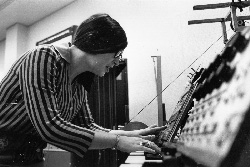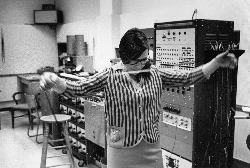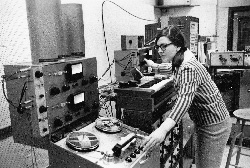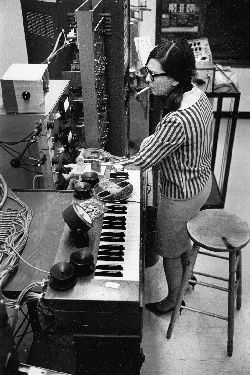Remembering Hugh Le Caine
The centenary of the birth of Hugh Le Caine was celebrated in a special event co-presented by the Music Gallery and the Canadian Music Centre in Toronto on 30 May 2014.“100 Years of Hugh Le Caine” was hosted by Le Caine biographer Gayle Young and included presentations by several guest speakers on this Canadian inventor and instrument builder as well as a concert programme around Le Caine’s artistic creations. The audience was treated to histories and reminiscences surrounding the early electronic music studio in Canada, and Le Caine’s unique role in its development. In this issue of eContact! we are pleased to publish presentations given by Robert Aitken, Norma Beecroft, alcides lanza and Pauline Oliveros at the event.
My memories of Hugh Le Caine are somewhat ephemeral. He was always a presence at any event in the 1970s that involved electronic music — a quiet presence, however, in spite of being a large man, whose intense manner one could not help notice. One had the impression that he was very shy, but as Gayle Young has informed us in her book The Sackbut Blues, Hugh Le Caine could be the life of a party — if he chose — but it seems as though all his enthusiasm and creativity was funnelled to his intense love of music, whether playing the piano or designing instruments for musical purposes (Fig. 1). 1[1. The author would like to acknowledge Gayle Young for her incredible and revealing documentation on the life of Hugh Le Caine in The Sackbut Blues. We are so much richer because of the information she has collected — a big thank you, Gayle.]
I had the pleasure of being a guest in his house in Ottawa for lunch back in the ’70s, but in retrospect I think my timing for this meeting was all wrong. I subsequently learned that was in this period, 1974 to be precise, that he had resigned from the National Research Council, undoubtedly a depressing time when he must have felt that all his work on devices for use in electronic music studios was a futile pursuit. I have been racking my brain to remember that brief meeting with Hugh and his wife, Trudi, at their house, but not one positive word in connection with electronic music comes to my mind.

I conducted a lengthy interview in the late ’70s with Gustav Ciamaga, who was the Director of the University of Toronto Electronic Music Studio, and one who knew Hugh Le Caine very well. 2[2. The author’s interviews with a range of Canadian and international figures, some of whom are intimately familiar with Le Caine’s work, is distributed by the Canadian Music Centre as an eBook, Conversations With Post World War II Pioneers of Electronic Music] Before Gus even came to Toronto, he consulted with Hugh Le Caine, among others, for advice on setting up an electronic music studio at Brandeis University, which was to be the second of such studios in the United States. So Hugh Le Caine was well known in those tight circles in the early days of electronic music. In fact, as Gus Ciamaga outlined in this interview: “The twentieth century is dotted with experimental music instruments based on available technology, in some cases electricity, and consequently it fits an umbrella term ‘electronic music’.” 3[3. Read the author’s interview with Gustav Ciamaga in this issue of eContact!] Le Caine was a walking encyclopaedia on this information; he could describe a whole range of instruments that were built (by himself or others) and could conjure up the kind of sounds they made. He was an extremely important person, well respected in the milieu for his wide knowledge of music as well as of other contemporary practices. For example, he was quite aware of experimental cinema, etc.
Travelling back into time, somewhere in the year 1956–57, the Canadian Music Associates, the concert committee of the Canadian League of Composers, had invited Vladimir Ussachevsky to Toronto to demonstrate his new “tape music”. Ussachevsky, who we all know was the co-founder of the Columbia-Princeton Electronic Music Center, talked about manipulating sounds recorded on tape, and played his Sonic Contours (premiered at the Museum of Modern Art in 1952), a piece made from pre-recorded piano sounds. Well, I was captivated by the idea. I was familiar with what was going on in the musical world through my work at the CBC, the musique concrète experiments at the French Radio in particular, through my access to recordings from the International Service of the CBC.
In 1958, I went to Tanglewood on a scholarship to further my studies with Lukas Foss and Aaron Copland. Two of my colleagues there were to become well known in the musical world, Zubin Mehta and Claudio Abbado, both conductors. In fact Claudio conducted my first orchestral composition there with the student orchestra. And it was Claudio who encouraged me to go to Europe and study with Petrassi.

So in 1959, I left Canada for a three-year period of study in Europe, and of course was exposed to many new musical concepts, including the activities at that home for the so-called avant-garde, Darmstadt. Before I left Canada, I had heard rumblings of setting up an electronic music studio at the Faculty of Music of the University of Toronto, and lo and behold, when I returned in 1962, the new studio was a fait accompli. However, it was only open to students of the Faculty, and I was definitely an outsider. I think I was finally permitted access because the CBC had donated equipment to the new studio, and I was an employee of the CBC!!! I’ll never know that answer.
In Europe, especially in Cologne, a composer wanting to work in electronic music in those early years could have a “Tonmeister” to assist him or her, otherwise, a person who could solve the technical problems in order for the composer to realize his ideas. As I did not have access to the Toronto studio immediately, I was accepted at Columbia University in New York to work on my first piece with tape, and I had the pleasure of having a brilliant composer Mario Davidovsky assisting me. This was 1963 or ’64, and the piece was gigantic, for orchestra, solo soprano, narrator, choir and tape — everything but the kitchen sink! From Dreams of Brass was the title.

My second composition with tape was more modest, based on poetry by Leonard Cohen, of course before he became famous singing his own words. “Elegy” and “Two Went to Sleep” were the poems I chose, and the latter was set for flute, spoken voice, percussion and 2-channel tape (later reworked for two separate stereo tape parts). It was premiered in 1967 by the Lyric Arts Trio — Robert Aitken 4[4. Robert Aitken’s own experiences on “Learning to Listen: Composing on Hugh Le Caine’s instruments in UTEMS ca. 1962” are also included in this issue of eContact!], Mary Morrison, with the percussion part adapted for piano by Marion Ross — and then recorded by Radio Canada International. I produced the tape at the University of Toronto Electronic Music Studios (UTEMS).
Let me tell you about reality of working at UTEMS in the 1960s. You worked on your own in a studio that was really not set up for one person to operate. The Ampex tape recorders were against one wall and processing devices near two other walls (Fig. 3). And of course there was Hugh Le Caine’s Multi-track device, and other equipment designed by him as well. I was attracted to the Multi-track as I thought it offered me the possibility of extending the recorded sounds made by traditional instruments or the voice into sometimes almost unrecognizable, but timbrally related sounds, which I could relate to the live performers. So off I went.

This device had six playback heads on which were placed tape loops of pre-recorded sounds. By pressing a note on the keyboard, you set the heads in motion, and by a sliding panel behind the keyboard you could speed up or slow down the speed of the tape heads, thus altering the pitch each time you moved. I think the original idea was to have six tape loops of short duration that would create a kind of ostinato, or a repetitious sound montage, changing speed, etc. This did not interest me, so what I did was make six tape loops of varying lengths, each containing sounds which I had previously recorded of Mary and Bob, and strung them across the room, or attached them to a mike stand or whatever I could find. These loops were weighted down with metal hooks so they ideally wouldn’t bunch up and break — and I emphasize the word “ideally”. When this setup was ready to go, you tore across the room to push the record button on the Ampex, and then tore back to the Multi-track and set the apparatus in motion. Simple, eh? Well, no. Often when changing the speed, one or more of the weights would fall down and the whole operation ground to a halt. You started all over again. And this procedure was repeated many times to end up with an acceptable result. Of course, it is dated now, but in those days we learned a lot about producing electronic music hands-on — especially to be patient.
Social top